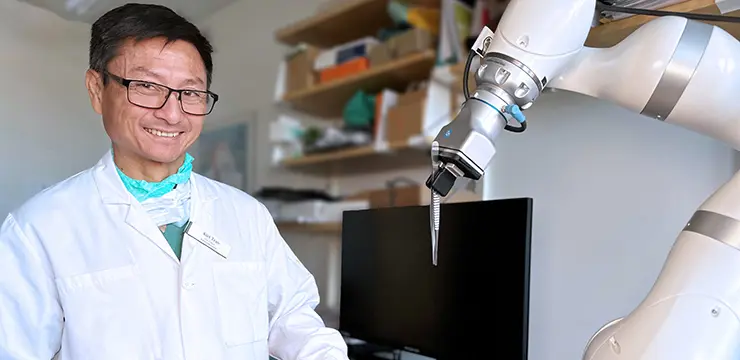Paediatric heart surgeon develops future robotic colleague

A child's heart is often no larger than a plum, and an artery only a few millimetres thick. Operating on such a small heart is complex and requires highly specialised knowledge. For a surgeon, it can take between 15 and 20 years to master every aspect. Each new generation of surgeons requires the same lengthy training before they are ready to operate on children's hearts.
"As a surgeon, I often feel inadequate. I can't operate on as many patients or learn as much as I would like in the short time I have to work," says Phan-Kiet Tran, senior consultant in paediatric heart surgery at Skåne University Hospital and associate professor at Lund University.
This dilemma led him to reflect: How can paediatric heart surgery treat more patients while ensuring that knowledge is transferred more quickly and easily between different generations of surgeons? The answer was to use artificial intelligence to create a robotic colleague in the operating room.
Trained with image data
The project, named CAISA (Collaborative Artificial Intelligent Surgical Assistant), recently received a 10 million SEK grant from the innovation agency Vinnova. The robotic colleague will be trained using image data from heart surgeries at Skåne University Hospital and other hospitals, along with computer-generated data.
The goal is that in three years, the robotic assistant will have learned to recognize 20 surgical instruments and be able to hand them to the surgeon during an operation. It will also have learned to recognise five anatomical structures of a heart.
"But that's just one step along the way. The real difference for patients will occur when we have developed CAISA to the point where the robot can perform certain simpler tasks during surgery, such as suturing two blood vessels or closing an opening in the heart. I believe it can develop to do this with better precision than a human, thus increasing patient safety with the help of AI," says Phan-Kiet Tran, who believes this goal is not far off:
"What we are developing today within AI, I thought was impossible just five years ago. Now we are facing a situation where the technology has the potential to revolutionize surgery in the near future."
Large memory capacity
As for knowledge transfer between surgeons? The goal with CAISA is to continue training the robot by continuously feeding it data from surgeries worldwide. In theory, this could mean that the robot gathers information and learns from up to 1,000 surgeries per day.
"This could mean that it takes just one day for the robot to acquire the same knowledge that takes me ten years to learn. The robot will also have a memory capacity that I, as a surgeon, regardless of how skilled I am, will never possess."
Having access to that capacity in the operating room could mean that new surgeons will always have an experienced robotic colleague to consult.
"In this way, there will be no loss of knowledge when my colleagues and I retire because we will have transferred our knowledge to the robot."
Some tasks cannot be replaced
For now, the project is starting to gather the necessary image data to train the robot. At the beginning of the project, they will also determine which surgical instruments the robot should learn to recognise and handle.
Although the project aims to take over certain aspects of a surgeon's role during an operation, some tasks can never be replaced by artificial intelligence, such as communication between people and understanding who is lying on the operating table.
"We operate on children to help them fulfil their dreams. We aim to help the child one day go to school, run, and play like all other children. A robot can never grasp that perspective—but it can perform certain surgical tasks just as well as I can," says Phan-Kiet Tran, adding:
"My motivation as a surgeon isn't the surgery itself but being able to call the parents afterward and tell them everything went well. At that moment, it doesn't matter whether it was me or a robot that performed parts of the operation."
Facts: CAISA
- The CAISA project (Collaborative Artificial Intelligent Surgical Assistant) is a collaboration between Skåne University Hospital, the Departments of Computer Science and Automatic Control at Lund University, Cobotic AB, and Cognibotics AB.
- Supported by the innovation agency Vinnova, the project aims to develop an AI surgical assistant to improve the quality and safety of paediatric heart surgery.
- The project utilises technologies such as robotic control and computer vision and is divided into five stages: data learning, pattern recognition, neural network architecture, and fine-tuning.
- The project will run from 2024 to 2027.
Facts: Paediatric heart surgery at Skåne University Hospital
- Skåne University Hospital is one of two hospitals in Sweden that provides nationally specialised care in paediatric heart surgery.
- In addition to its national mandate, it has an agreement with Iceland, which sends its paediatric heart patients to Skåne University Hospital for treatment.
- Skåne University Hospital has some of the foremost experts in paediatric heart surgery and access to specially adapted intensive care and surgical resources.

